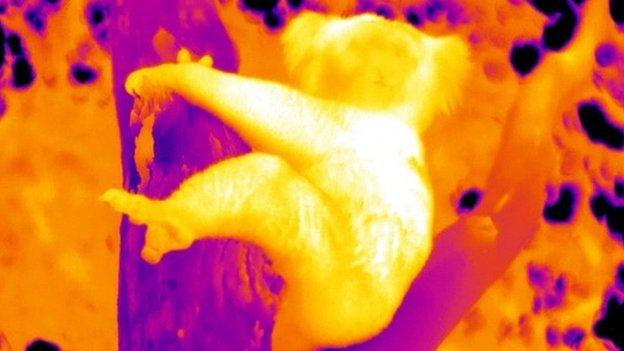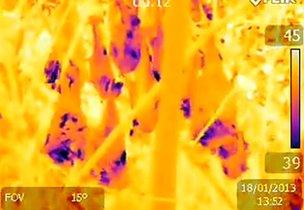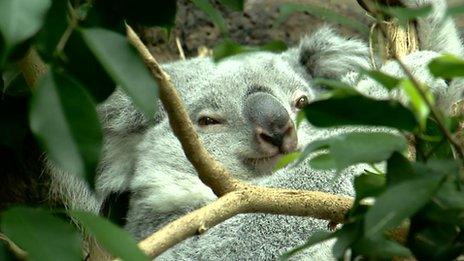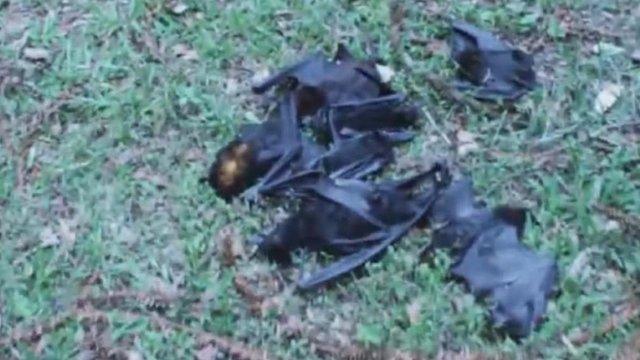Koalas hug trees to lose heat
- Published
Dr Michael Kearney from the University of Melbourne explains how the koalas hug trees to regulate their temperature
Hugging trees helps koalas to keep cool, a study has revealed.
In a study published in the Royal Society journal Biology Letters, external, scientists used thermal cameras to reveal that, in hotter weather, the animals moved to the lower, cooler parts of the trees.
They also pressed their bodies even closer to the trunks.
The team, led by researchers from the University of Melbourne, was studying how koalas regulated their temperature.

Thermal images revealed how cool the trunks of large trees were
This is part of a wider research project investigating the effect of climate on land-dwelling animals in Australia, a country which experienced an extreme heat wave earlier this year.
While PhD student Natalie Briscoe was studying the koalas' behaviour, she noticed that in the winter the animals would stay high in the trees - up near the leaves feeding.
In the hotter summer weather though, they would move down.
Dr Michael Kearney from the University of Melbourne explained: "They'd just flop over the [lower] tree trunks.
"It looked like they were spread-eagled and uncomfortable; it seemed like the wrong thing to do."
But measurements of the temperatures of the tree trunks showed that, on days as hot as 39C, they were up to seven degrees cooler than the air.
See a male koala making the extraordinary bellowing sounds (footage by Benjamin D Charlton at Lone Pine Koala Sanctuary, Brisbane)
"That's what made us wonder if the koalas were using the trees as a heat sink," said Dr Kearney.
The team used a thermal camera to take pictures of koalas on a particularly hot day.
"When we got the images, back it was so obvious what the koala was doing," explained Dr Kearney. "You could see the koala sitting on the coolest part of the tree trunk with its bottom wedged right into the coolest spot.
"If we had thermal vision, it would have been an obvious thing."
Deadly heat
Dr Kearney said large trees had their own protective "microclimate", which is likely to become increasingly important to tree-dwelling creatures like koalas if global temperatures continue to increase as predicted.

Thermal images of flying foxes reveals their response to heat stress
Another researcher who has used thermal cameras in his ecological research - Dr Justin Welbergen from James Cook University - says thermal images show exactly how animals can exploit these cooler microclimates in trees.
"This helps them to maximise their chances of survival during extreme heat events," He told BBC News.
Research Dr Welbergen published earlier this year revealed the effects on wildlife of such extreme events. His research revealed that 45,500 flying foxes had died on just one extremely hot day in southeast Queensland.
"Our thermal video shows group of flying-foxes trying to cope with an extreme heat event by distributing saliva on their wings," he explained.
Hugging trees, Dr Kearney said, helps the koalas to avoid similar water loss - enabling them to "dump heat" into the tree and to avoid panting.
Follow Victoria on Twitter , external
- Published2 December 2013

- Published19 September 2013

- Published10 January 2014
